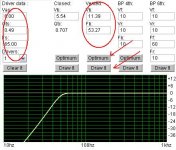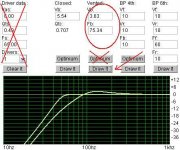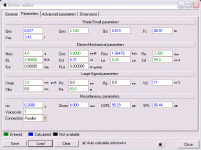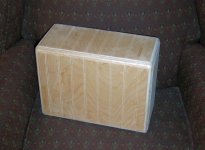I'm building a portable, outdoor pa use, portable speaker to fit a bicycle rack. Winisd's ported box figure for a pair of Monacor SP-60/4 was too big and didn't seem to represent any stuffing, so either ported or stuffed port is fine, but the WinISD size is not. I also need cabinet bass emphasis to about +5 for outdoor use tuning and that should help to shrink the size a bit.
I've really no clue for cabinet size (the pair in a single cabinet). Help?
I need your suggestions.
Here's some figures for the speaker.
Impedance (Z) 4Ω
Resonant frequency (fs) 65Hz
Suspension compl. (Cms) 0.8mm/N
Moving mass (Mms) 4g
Mech. Q factor (Qms) 2.10
Electr. Q factor (Qes) 0.64
Total Q factor (Qts) 0.49
Equivalent volume (Vas) 6 l
DC resistance (Re) 3.3Ω
Force factor (BxL) 2.9Tm
Voice coil induct. (Le) 0.2mH
Voice coil diameter 25.5mm
Linear excursion (XMAX) ±2mm
Eff. cone area (Sd) 55cm2
I've really no clue for cabinet size (the pair in a single cabinet). Help?
I need your suggestions.
Here's some figures for the speaker.
Impedance (Z) 4Ω
Resonant frequency (fs) 65Hz
Suspension compl. (Cms) 0.8mm/N
Moving mass (Mms) 4g
Mech. Q factor (Qms) 2.10
Electr. Q factor (Qes) 0.64
Total Q factor (Qts) 0.49
Equivalent volume (Vas) 6 l
DC resistance (Re) 3.3Ω
Force factor (BxL) 2.9Tm
Voice coil induct. (Le) 0.2mH
Voice coil diameter 25.5mm
Linear excursion (XMAX) ±2mm
Eff. cone area (Sd) 55cm2
WinISD seems to say that the pair of woofers fits a 10.5 liter box, if minimum sized, and any smaller would be much harder to tune. Is that correct?
So, my question is, would an aperiodic go a smaller and/or have more bass extension than ported?
P.S.
Also driving each woofer from a series cap, of 1000u (-0db@80hz, -3db@60hz -6db@40hz), to give the TA2020 battery powered amplifier decreased load at subharmonic (running 60z at 1/2 power, 40hz at 1/4 power saves the battery) and, in theory, slightly flub the electronic dampening at lowest pitches to fit smaller box. That's a modest trick at best. Yet, in a 0.5l cardboard box, one of these little woofers is doing unexpectedly well on bass.
So, my question is, would an aperiodic go a smaller and/or have more bass extension than ported?
P.S.
Also driving each woofer from a series cap, of 1000u (-0db@80hz, -3db@60hz -6db@40hz), to give the TA2020 battery powered amplifier decreased load at subharmonic (running 60z at 1/2 power, 40hz at 1/4 power saves the battery) and, in theory, slightly flub the electronic dampening at lowest pitches to fit smaller box. That's a modest trick at best. Yet, in a 0.5l cardboard box, one of these little woofers is doing unexpectedly well on bass.
I'd put the series cap at line level - at speaker level it'll interact with the impedance peaks in interesting ways (usually a peak in output at each impedance peak - when one of the peaks is below port tuning, this isn't desirable).
For outdoors use, its worth avoiding a flat alignment - its difficult to get LF outdoors, so (using a trick that's been in the HiFi industry for years) use the port to create a bump in the response before rolloff - that way, it sounds like there's bass without there being any.
Chris
For outdoors use, its worth avoiding a flat alignment - its difficult to get LF outdoors, so (using a trick that's been in the HiFi industry for years) use the port to create a bump in the response before rolloff - that way, it sounds like there's bass without there being any.
Chris
For optimum "boombox" tuning intended for outdoors use. You need to tune the cabinet to Q=1.207, instead of Q=0.707 as is the normal compromise used in indoors intended (home stereo) speakers. The result will be roughly same in audio quality, so pay no heed to people saying that it will have sloppy bass as that is not the case. In fact in audio quallty, you can basically say that outdoor Q/2 = indoors Q. So it's in fact even better dampened at Q=1.207 than an indoors speaker is at Q=0.707.
To figure out the optimum cabinet size, use winISD or other software and assume Q=0.707. Take the Vb (box volume) from that and divide with Pi. And take the Fb (box resosnant frequency) and multiply by square root of 2.
In short:
Indoors Q = outdoors Q / 2 (assumes that we compare speakers in a small room to semi-free field where speaker is relatively close to ground)
Vb = Vb / Pi
Fb = Fb * 2^0.5
As for using a series cap. Don't bother. Change the input cap on the amp instead.
To figure out the optimum cabinet size, use winISD or other software and assume Q=0.707. Take the Vb (box volume) from that and divide with Pi. And take the Fb (box resosnant frequency) and multiply by square root of 2.
In short:
Indoors Q = outdoors Q / 2 (assumes that we compare speakers in a small room to semi-free field where speaker is relatively close to ground)
Vb = Vb / Pi
Fb = Fb * 2^0.5
As for using a series cap. Don't bother. Change the input cap on the amp instead.
Last edited:
To further expand on the above.
If you plot the new Vb and Fb figures into winISD, you'll notice a 2.83dB peak (usually) somewhere in the 120-160Hz area. In psychoacoustic effect that corresponds to being perceived as flat to that frequency divided with square root of 2. So if it peaks at 144Hz, it's perceived flat to 100Hz.
In principle perceived flat means exactly that. Output without noticable loss. So it doesn't correspond to the normal -3dB point which is the frequency where output is noticeably lower but rather the start of the roll-off in regular tuning. For something that corresponds closely to a -3dB point, assume that it goes about 10% lower in frequency than the above calculation indicate as the flat frequency range.
If you plot the new Vb and Fb figures into winISD, you'll notice a 2.83dB peak (usually) somewhere in the 120-160Hz area. In psychoacoustic effect that corresponds to being perceived as flat to that frequency divided with square root of 2. So if it peaks at 144Hz, it's perceived flat to 100Hz.
In principle perceived flat means exactly that. Output without noticable loss. So it doesn't correspond to the normal -3dB point which is the frequency where output is noticeably lower but rather the start of the roll-off in regular tuning. For something that corresponds closely to a -3dB point, assume that it goes about 10% lower in frequency than the above calculation indicate as the flat frequency range.
Last edited:
Seems good, but unfortunately I couldn't read it well enough to do the maths, there being no similar examples to follow for decoding it. So, what's the cabinet size?Indoors Q = outdoors Q / 2 (assumes that we compare speakers in a small room to semi-free field where speaker is relatively close to ground)
Vb = Vb / Pi
Fb = Fb * 2^0.5
When playing with the WinISD, I was going for attempting a +5 bump on the bass for outdoor tuning. That got it down to 10.5l. Could it be made smaller?
Seems good, but unfortunately I couldn't read it well enough to do the maths...
No idea what the problem is but I'll just let these 2 pictures explain it instead.
Attachments
Thank you!
My USA university education was enough to avoid making WinISD's implausible footlockers, but not enough to replace that with the right size cabinet. Since the cabinet sizes you've shown look much more plausible/practical, I would love to know what software you've used?
Anyway, if I read it right, that software gives accurate close box figures and I subtract a third of the box for ported.
It appears to be for a single driver. Am I correct in assuming that 3.63l *2 is suitable for 2 of Monacor SP-60/4? Inflating the cabinet to make room for my epic amount of circuit boards and the batteries results in an estimated 8l size cabinet. Correct?
My USA university education was enough to avoid making WinISD's implausible footlockers, but not enough to replace that with the right size cabinet. Since the cabinet sizes you've shown look much more plausible/practical, I would love to know what software you've used?
Anyway, if I read it right, that software gives accurate close box figures and I subtract a third of the box for ported.
It appears to be for a single driver. Am I correct in assuming that 3.63l *2 is suitable for 2 of Monacor SP-60/4? Inflating the cabinet to make room for my epic amount of circuit boards and the batteries results in an estimated 8l size cabinet. Correct?
With 6mm hardened birch composite, my enclosure size for 2 Monacor sp-60/4 is?
23.5cm (slightly below saddle height)
13.4cm (slightly wider than bicycle rack)
31cm (slightly longer than bicycle rack)
This fits the bicycle well.
I hope the size is right for the speakers.
Starting to cut lumber. . .
Remaining question:
Number of port tube(s)?
Diameter of port tube(s)?
Location of port tube(s)?
23.5cm (slightly below saddle height)
13.4cm (slightly wider than bicycle rack)
31cm (slightly longer than bicycle rack)
This fits the bicycle well.
I hope the size is right for the speakers.
Starting to cut lumber. . .
Remaining question:
Number of port tube(s)?
Diameter of port tube(s)?
Location of port tube(s)?
Here's some figures for the speaker.
Impedance (Z) 4Ω
Resonant frequency (fs) 65Hz
Suspension compl. (Cms) 0.8mm/N
Moving mass (Mms) 4g
Mech. Q factor (Qms) 2.10
Electr. Q factor (Qes) 0.64
Total Q factor (Qts) 0.49
Equivalent volume (Vas) 6 l
DC resistance (Re) 3.3Ω
Force factor (BxL) 2.9Tm
Voice coil induct. (Le) 0.2mH
Voice coil diameter 25.5mm
Linear excursion (XMAX) ±2mm
Eff. cone area (Sd) 55cm2
FYI, when I load the theoretically most accurate specs [Sd, Re, Cms, Mms, BL, Qms], WinISD Pro calculates significantly different specs than T/S, making the cab significantly larger & tuned higher.
GM
Attachments
Am I correct in assuming that 3.63l *2 is suitable for 2 of Monacor SP-60/4?
To maintain the same response, tuning, yes. Note that the number of vents double also. That, or a single larger one that maintains ~ the same vent efficiency.
GM
Vents?
Two small vents/ports less boomy than one large vent/port?
Well, for the enclosure pictured in post 14, where do the vents/ports go?
I'm not experienced with ported speakers (except for refit/repair jobs), so I need someone experienced to tell me where to put the holes. Help?
P.S.
There is a speaker for the largest panel on front and there is a speaker for the largest panel on back. It is a bipolar outdoor speaker arranged for maximum broadcast range.
Two small vents/ports less boomy than one large vent/port?
Well, for the enclosure pictured in post 14, where do the vents/ports go?
I'm not experienced with ported speakers (except for refit/repair jobs), so I need someone experienced to tell me where to put the holes. Help?
P.S.
There is a speaker for the largest panel on front and there is a speaker for the largest panel on back. It is a bipolar outdoor speaker arranged for maximum broadcast range.
Remaining question:
Number of port tube(s)?
Diameter of port tube(s)?
Location of port tube(s)?
Depends on what physically fits best overall.
Depends on the amount of power they need to handle at a low vent mach [air velocity], i.e. < ~17.2 m/sec at box tuning [Fb].
What Fb are you planning to use and how much power are the drivers likely to need and/or is available?
In acoustically small cabs, i.e. its pass-band WLs are very large compared to the vet box volume [Vb], vents can be positioned anywhere and they will still seamlessly sum, so wherever on the cab it’s convenient.
GM
Two small vents/ports less boomy than one large vent/port?
Not if they have ~the same efficiency, i.e. vent mach. When there’s lots of vents Vs one though, such as an Onken alignment, there will be differing audible performance due to the individual vent’s harmonic structure, acoustical damping.
GM
I don't know how to answer the FB question, except that I'm trying to stay near the specs that Saturnus posted. I pepped up the cabinet size slightly, to make room for frame, braces, batteries, and quite a few circuit boards.What Fb are you planning to use and how much power are the drivers likely to need and/or is available?
Amp power:
TA2020+ClipNipper running on solar+battery in the range of ~12v to 15.3v (overcharge protect drainers have switched on at 15.3v, amp actually runs normally at typical automotive voltages 13.5 to 14.8 range). There's also a dual asymmetric soft clipper installed at input to help prevent x-max. The soft clippers and the limiter were both aligned while the amp was running from a 12vdc regulated source. So, consider 20 watts per channel +5db more headroom.
I do favor a greater number of smaller ports, sounds more like aperiodic (less boomy) but easier to calculate. But I don't know how many ports to use.Not if they have ~the same efficiency, i.e. vent mach. When there’s lots of vents Vs one though, such as an Onken alignment, there will be differing audible performance due to the individual vent’s harmonic structure, acoustical damping.
There's speaker drivers on both sides of the enclosure, and so for balanced stereo, do I need ports on both sides of the enclosure?
Last edited:
OK, so a ~75.33 Hz tuning [Fb].
OK, with this tuning you’ll run out of linear travel at ~2 W, so allowing for a little overdrive, 5 W max below Fb. Hope your limiter never fails.
At only 5 W, the vents can be quite small, 2.5 cm dia. x 5.3 cm long.
Again, you can put the vents wherever they will fit since the diameter of a 75 Hz WL is ~57.55” and/or where they sound best overall to you, though in theory you shouldn’t be able to hear any difference unless you overdrive the cab so hard that the vents audibly ‘whistle’/’chuff’.
That said, the pioneers of audio concluded that for a simple reflex like this one, putting the vents as close as practical to the driver is best overall, so your call.
GM
OK, with this tuning you’ll run out of linear travel at ~2 W, so allowing for a little overdrive, 5 W max below Fb. Hope your limiter never fails.
At only 5 W, the vents can be quite small, 2.5 cm dia. x 5.3 cm long.
Again, you can put the vents wherever they will fit since the diameter of a 75 Hz WL is ~57.55” and/or where they sound best overall to you, though in theory you shouldn’t be able to hear any difference unless you overdrive the cab so hard that the vents audibly ‘whistle’/’chuff’.
That said, the pioneers of audio concluded that for a simple reflex like this one, putting the vents as close as practical to the driver is best overall, so your call.
GM
- Status
- This old topic is closed. If you want to reopen this topic, contact a moderator using the "Report Post" button.
- Home
- Loudspeakers
- Multi-Way
- Pair Monacor SP-60/4 in a stuffed port aperiodic cabinet? What size cabinet?



